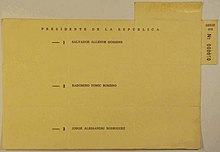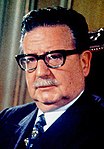1970 Chilean presidential election
| |||||||||||||||||||||||||||||
| |||||||||||||||||||||||||||||
| |||||||||||||||||||||||||||||

Presidential elections were held in Chile on 4 September 1970. Salvador Allende of the Popular Unity alliance won a narrow plurality in the public vote, before having his victory confirmed by a Congressional vote after the Christian Democrats voted in favour of his candidacy.
Eduardo Frei Montalva and his Christian Democratic Party would later unite with Allende's opponents to form a congressional majority in an attempt to declare his presidency illegal in August 1973, catalyzing the military coup a few weeks later.
Electoral system[]
The election was held using the absolute majority system, under which a candidate had to receive over 50% of the popular vote to be elected. If no candidate received over 50% of the vote, both houses of the National Congress would come together to vote on the two candidates that received the most votes.[1]
Campaign[]
According to Alessandri's appearance on TV backfired and cost him the election. On the TV program Tres Bandas hosted by there were two separate shots that showed him in bad light. In the first Alessandri said that he would be determined and that his "hands would not shake", subsequently the camera focused his hands that were actually shaking. In the second frame he was seen next to a stove warming his legs with a blanket despite being Spring. According to Riesenberg all this gave the public the impression of a man who was not longer "in an adequate age to become president".[2]
Both the Central Intelligence Agency (CIA) and the KGB spent significant amounts of money to influence the outcome of the election.[3]
The CIA did not provide direct assistance to any candidate, as they had during the 1964 elections, but rather focused on anti-Allende propaganda, and the 40 Committee approved $435,000 for that purpose.[4] In fact that represented only about half the money spent by the CIA to influence the election; the Church Committee put the total amount at between $800,000 and $1 million.[5] The money approved by the 40 Committee was used in a "scare campaign" of posters and pamphlets linking an Allende victory with the violence and repression associated with the Soviet Union.[3] Editorials and news stories reinforcing this message were also written with CIA guidance, especially in the newspaper El Mercurio, and disseminated throughout the national media. The goal was to contribute to and exploit the political polarization and financial panic of the period. Besides propaganda, the CIA also funded an attempt to splinter the Radical Party away from the Popular Unity coalition.[6][7] This CIA campaign was very inefficient. CIA director Richard Helms complained that he was ordered by the White House to "beat somebody with nobody".[3] Although the 40 Committee had decided not to support any candidate directly, the CIA did help US companies in funding candidates. In total, US businesses spend about $700,000; half of that sum was provided by the International Telephone & Telegraph Corporation (ITT).[5]
KGB money was more precisely targeted. Allende made a personal request for Soviet money through his personal contact, KGB officer Svyatoslav Kuznetsov, who urgently came to Chile from Mexico City to help Allende. The original allocation of money for these elections through the KGB was $400,000, and an additional personal subsidy of $50,000 directly to Allende.[3] It is believed that help from KGB was a decisive factor, because Allende won by a narrow margin of 39,000 votes of a total of the 3 million cast. After the elections, the KGB director Yuri Andropov obtained permission for additional money and other resources from the Central Committee of the CPSU to ensure Allende victory in Congress. In his request on 24 October, he stated that KGB "will carry out measures designed to promote the consolidation of Allende's victory and his election to the post of President of the country".[3]
US president Richard Nixon was enraged by Allende's victory and the failure of the CIA's covert actions against him.[3]
Congressional confirmation[]
As none of the candidates received an absolute majority of votes, the National Congress had to decide between the two candidates who had received the most votes, Allende and Alessandri. The precedent set on the three previous occasions this situation had arisen since 1932 was for Congress simply to choose the candidate with the highest number of votes; indeed, former President Alessandri had been elected in 1958 with 31.6% of the popular vote, defeating Allende.
In this case, however, there was an active campaign against Allende's confirmation by Congress, including an intensification of the CIA propaganda campaign to create concerns about Chile's future. During this period the CIA generated over 726 articles, broadcasts and similar items. The CIA also encouraged international economic pressure against Chile during this period. The United States also began to lay the groundwork for a military coup in this stage, authorizing the Ambassador to Chile to encourage this outcome with his contacts in the Chilean military.[8]
Two days before the confirmation, Army Commander-in-Chief General René Schneider, was shot resisting a kidnap attempt by a group led by General Roberto Viaux. Hospitalized, he died of his wounds three days later. Viaux's kidnapping plan had been supported by the CIA.[9] Schneider was a known defender of the "constitutionalist" doctrine that the army's role is exclusively professional, its mission being to protect the country's sovereignty and not to interfere in politics, and had expressed his deep opposition to organizing a coup d'état in case Salvador Allende was finally chosen by the National Congress as President. Schneider's death was viewed negatively by the public, and helped citizens and military support Allende, whom the National Congress finally chose on 24 October. On 26 October, President Eduardo Frei named General Carlos Prats as commander in chief of the army in replacement of René Schneider.
Allende's presidency was eventually ratified, after he agreed to sign a "Statute of Constitutional Guarantees", promising not to undermine the Chilean Constitution.
Results[]
| Candidate | Party/Coalition | Votes | % | Result |
|---|---|---|---|---|
| Salvador Allende | Popular Unity (UP) | 1,070,334 | 36.61 | Congressional confirmation |
| Jorge Alessandri Rodríguez | National Party | 1,031,159 | 35.27 | Congressional confirmation |
| Radomiro Tomic | Christian Democratic Party | 821,801 | 28.11 | |
| Total valid votes | 2,923,294 | 100.00 | ||
| Blank votes | 7,045 | 0.23 | ||
| Null votes | 24,460 | 0.82 | ||
| Total votes | 2,954,799 | 100.00 | ||
| Registered voters | 3,539,747 | 83.47% turnout | ||
| Voting-age population | 5,266,331 | 56.11% turnout | ||
| Source: Tricel;[10][11] UNDESA.[12] | ||||
Congressional confirmation[]
| Candidate | Party/Coalition | Votes | % | Result |
|---|---|---|---|---|
| Salvador Allende | Popular Unity (UP) | 153 | 78.46 | President |
| Jorge Alessandri Rodríguez | Independent conservative | 35 | 17.95 | |
| Blank votes | 7 | 3.59 | ||
| Total votes | 195 | 100.00 | ||
| Absent | 5 | 2.50 | ||
| Eligible voters | 200 | 97.50% turnout | ||
| Source: Tricel.[10] | ||||
See also[]
- History of Chile
- U.S. intervention in Chile
- Chilean coup of 1973
References[]
- ^ Nohlen, D (2005) Elections in the Americas: A data handbook, Volume II, p259 ISBN 978-0-19-928358-3
- ^ Sergio Riesenberg: "La derrota de Jorge Alessandri se debe a la televisión" (in Spanish). Cultura Verdadera. 13 December 2015.
- ^ Jump up to: a b c d e f Vasili Mitrokhin and Christopher Andrew, The World Was Going Our Way: The KGB and the Battle for the Third World, Basic Books (2005) hardcover, 677 pages ISBN 0-465-00311-7, pages 69-88.
- ^ Prados, John (2006). Safe for Democracy: The Secret Wars of the CIA. Ivan R. Dee. p. 405–406. ISBN 9781615780112.
- ^ Jump up to: a b Church Committee (1975). "Covert Action in Chile: 1963-1973". pp. 20–21.
- ^ Church Report (Covert Action in Chile 1963-1973) Archived 11 September 2009 at the Wayback Machine, United States Senate Church Committee, 1975
- ^ CIA Activities in Chile Archived 12 December 2006 at the Wayback Machine
- ^ Church Report, ibid
- ^ CIA Reveals Covert Acts In Chile Archived 7 August 2004 at the Wayback Machine, CBS News, September 19, 2000. Accessed 2 August 2006.
- ^ Jump up to: a b "El Partido Socialista de Chile Tomo II". Julio César Jobet (in Spanish). p. 120. Archived from the original (PDF) on 25 October 2009. Retrieved 5 June 2009.
- ^ "B. El Congreso Nacional y la quiebra de un deber constitucional: el control del ejercicio constitucional de las funciones del presidente". Revista Chilena de Derecho (in Spanish). 1 (3/4): 491–547. June–August 1974. JSTOR 41605133.
- ^ "Total Population - Both Sexes". World Population Prospects, the 2017 Revision. United Nations Department of Economic and Social Affairs, Population Division, Population Estimates and Projections Section. June 2017. Archived from the original on 30 July 2017. Retrieved 1 November 2017.
External links[]
- 1970 elections in South America
- 1970 in Chile
- Presidential elections in Chile
- Presidency of Salvador Allende
- September 1970 events in South America


